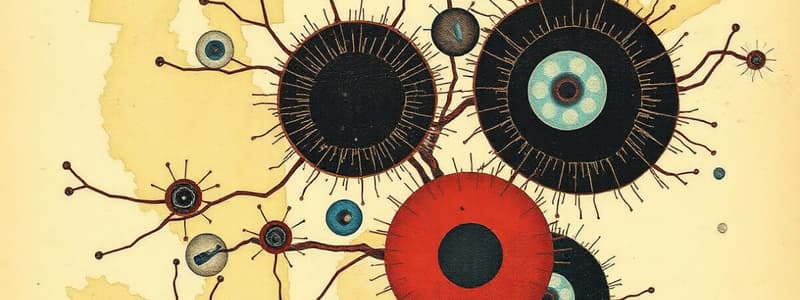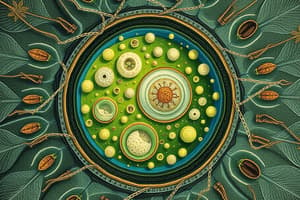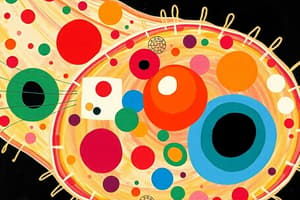Podcast
Questions and Answers
What do protozoa and fungi commonly have in common regarding disease causation in humans?
What do protozoa and fungi commonly have in common regarding disease causation in humans?
- Protozoa are more likely to cause disease than fungi. (correct)
- Fungi are primarily responsible for diseases like malaria.
- Both can cause significant diseases in immuno-compromised individuals. (correct)
- Fungi do not cause disease at all.
What is a unique characteristic of mitochondria that supports endosymbiotic theory?
What is a unique characteristic of mitochondria that supports endosymbiotic theory?
- They can only perform aerobic respiration.
- They replicate independently of the host cell. (correct)
- They possess a single strand of DNA.
- They are only found in prokaryotic cells.
How do some algae contribute to the ecosystem?
How do some algae contribute to the ecosystem?
- By recycling plant nutrients solely.
- By breaking down complex sugars.
- By producing large amounts of oxygen through photosynthesis. (correct)
- By consuming excessive carbon dioxide.
What is one of the lingering questions about endosymbiotic theory?
What is one of the lingering questions about endosymbiotic theory?
What disease is primarily associated with protozoa?
What disease is primarily associated with protozoa?
What role do eukaryal microbes play in biodegradation?
What role do eukaryal microbes play in biodegradation?
Which fungi are known to cause significant disease in plants?
Which fungi are known to cause significant disease in plants?
What common feature do mitochondria and nuclei share?
What common feature do mitochondria and nuclei share?
What is the role of the nucleus in eukaryal cells?
What is the role of the nucleus in eukaryal cells?
Which of the following accurately describes the structure of mitochondria?
Which of the following accurately describes the structure of mitochondria?
Which of the following is NOT a function of the plasma membrane?
Which of the following is NOT a function of the plasma membrane?
What is the primary role of the cytoskeleton in eukaryal cells?
What is the primary role of the cytoskeleton in eukaryal cells?
Which process occurs within the mitochondria?
Which process occurs within the mitochondria?
What distinguishes the cell walls of eukaryal microorganisms?
What distinguishes the cell walls of eukaryal microorganisms?
Which statement correctly describes the differences in motion between eukaryal and bacterial cells?
Which statement correctly describes the differences in motion between eukaryal and bacterial cells?
In eukaryal cells, what occurs during transcription?
In eukaryal cells, what occurs during transcription?
Chloroplasts in eukaryal cells are responsible for which of the following?
Chloroplasts in eukaryal cells are responsible for which of the following?
What is a characteristic feature of the endoplasmic reticulum (ER) in eukaryal cells?
What is a characteristic feature of the endoplasmic reticulum (ER) in eukaryal cells?
Which of the following statements accurately describes the role of Saccharomyces cerevisiae?
Which of the following statements accurately describes the role of Saccharomyces cerevisiae?
What is a primary feature of the Chytridiomycota group of fungi?
What is a primary feature of the Chytridiomycota group of fungi?
What distinguishes meiosis from mitosis in eukaryotic cell division?
What distinguishes meiosis from mitosis in eukaryotic cell division?
Which of the following statements regarding the life cycle of Chlamydomonas is true?
Which of the following statements regarding the life cycle of Chlamydomonas is true?
What is a key aspect of the Endosymbiotic Theory?
What is a key aspect of the Endosymbiotic Theory?
Which category represents organisms that are both heterotrophic and photosynthetic?
Which category represents organisms that are both heterotrophic and photosynthetic?
What unique reproductive strategy is exhibited by Dictyostelium discoideum?
What unique reproductive strategy is exhibited by Dictyostelium discoideum?
How are the reproductive strategies of Saccharomyces differentiated?
How are the reproductive strategies of Saccharomyces differentiated?
Which of these features is typical for Glomeromycota fungi?
Which of these features is typical for Glomeromycota fungi?
What type of motility is associated with the organism Chlamydomonas?
What type of motility is associated with the organism Chlamydomonas?
Flashcards are hidden until you start studying
Study Notes
Morphology of Typical Eukaryotes
- Eukaryotic cells are larger than bacterial or archaeal cells
- They contain organelles, a cell wall (not all), and a complex internal cytoskeleton
- Separated compartments within the cell, called organelles, aid in completing specific tasks
- The nucleus, responsible for storing genetic information, is surrounded by a double membrane
- It contains linear chromosomes and a nucleolus, responsible for ribosome synthesis
- The secretory pathway, involving the endoplasmic reticulum (ER) and Golgi apparatus, modifies proteins before they reach their destination
- Mitochondria, often dubbed "powerhouses of the cell", play a crucial role in cellular metabolism, specifically the tricarboxylic acid (TCA) cycle
- They utilize electron transport chains to generate ATP through chemiosmosis, driven by the proton motive force
- Chloroplasts, found in photosynthetic eukaryotes, contribute to cell metabolism
- Like mitochondria, they use electron transport chains to produce ATP via chemiosmosis and utilize this ATP to fix carbon into organic compounds, such as glucose
- Both mitochondria and chloroplasts are semi-autonomous; they have a DNA genome, ribosomes, and transcription machinery, allowing them to replicate independently
- While having their own genetic material, they still receive most of their proteins from the nuclear DNA of the cell
- The plasma membrane, composed of a phospholipid bilayer with embedded proteins, facilitates the transport of molecules between the inside and outside of the cell
- This transport occurs through either facilitated diffusion, which doesn't require energy from the cell, or active transport, which does expend energy
- It plays a pivotal role in maintaining homeostasis - a balanced internal environment
- The cell wall, present in many eukaryotes, provides structural support to the cell
- Cellulose and chitin, prevalent components of many cell walls, are made up of specific beta-1,4-glycosidic bonds between sugar molecules
- They contribute significantly to the strength and rigidity of the cell wall
- The cytoskeleton, crucial for maintaining cell structure, is composed of three major components: microtubules (made of tubulin), microfilaments (made of actin), and intermediate filaments (composed of various proteins)
- Each component has a unique structure and function, collectively contributing to cell shape
- The cytoskeleton is also involved in intracellular trafficking, movement, and cell division, which can be observed using fluorescent microscopy
- It assists in cell division by forming spindle fibers that help separate chromosomes
- Motion is achieved through cilia and flagella, which differ structurally from those found in bacteria
- In cilia and flagella, nine microtubule doublets form a tube around a central pair of microtubules, known as the axoneme
- Movement occurs when ATP is consumed, causing the microtubules in the axoneme to slide past each other
- Pathogens, like herpes simplex virus (HSV) and Listeria, can exploit the cytoskeleton to their advantage
Eukaryote Diversity
- The use of highly conserved genes, such as tubulins and heat shock proteins, allows scientists to better understand eukaryotic phylogeny
- Eukaryotes are classified into various categories, with a diverse range of characteristics
- Some eukaryotic microorganisms are categorized as protists, encompassing a variety of organisms with diverse characteristics, such as cell walls, motility, and reproductive strategies
- Examples of protists include diverse single-celled eukaryotes, some displaying heterotrophic modes of nutrition while others are photosynthetic
- Fungi, a distinct group of eukaryotic microorganisms, are heterotrophic and possess cell walls made of chitin
- They play an important role in various industries, such as baking and brewing, due to their ability to ferment sugars
- Saccharomyces cerevisiae, a commonly used yeast for research, provides insights into eukaryotic structures and gene expression
- Fungi exhibit diverse evolutionary pathways with distinct lineages:
- Chytridiomycota: An early-branching group of fungi, commonly known as "water molds"
- Zygomycota: Includes Rhizopus, the infamous bread mold often encountered in laboratory settings
- Glomeromycota: A significant group of mycorrhizal fungi forming crucial symbiotic relationships with plants
- Ascomycota: "Spore shooters" or "cup/sac" fungi, including yeasts
- Basidiomycota: "Spore droppers" or "club" fungi, responsible for producing the traditional mushrooms
- Protozoa, a diverse category of eukaryotic microorganisms, often have a variety of nutritional strategies, with some being heterotrophic and others photosynthetic
- They exhibit a range of cell wall structures, motility strategies, and reproduction mechanisms, making them a diverse group
- Giardia lamblia, a protist known to cause human disease, is genetically ancient and lacks mitochondria
- Slime molds, like Dictyostelium discoideum, provide a model for studying various aspects of biology, such as ecology, cell motility, and cell-cell communication
- Physarum, another type of slime mold, forms large, multinucleate giant cells through the fusion of multiple cells
- Algae are a diverse group of photosynthetic eukaryotic microorganisms, many of which are multicellular
- They share the characteristic of having cellulose cell walls
- Chlamydomonas, a single-celled alga, possessing two flagella, is a valuable model organism for studying flagella biogenesis and function due to its durability and ease of cultivation
Replication of Eukaryotic Microorganisms
- Eukaryotic microorganisms exhibit more complex life cycles compared to prokaryotes, often involving both haploid and diploid forms
- They can reproduce either sexually or asexually, adding complexity to their life cycles
- Mitosis, a basic form of cell division, involves the production of two identical cells from a single parent cell
- Meiosis, a specialized division process, results in four haploid daughter cells from a single diploid parent cell.
- It involves one round of DNA replication followed by two rounds of cell division
- It introduces genetic recombination, ensuring the segregation of maternal and paternal chromosomes
- "Crossing over" between chromosomes prior to segregation guarantees that each haploid cell is genetically distinct
- Saccharomyces (yeast) can undergo meiosis, leading to the formation of an ascus.
- Haploid mating types can fuse for sexual reproduction or maintain themselves through asexual mitosis
- While known for ascus formation, Saccharomyces can also reproduce through budding off smaller cells or fission of identically sized cells
- Chlamydomonas, an alga, maintains a motile haploid state.
- Haploid cells differentiate and fuse into a diploid form under adverse conditions, leading to spore formation
- Dictyostelium, a slime mold, exists as a haploid unicellular form until environmental conditions deteriorate.
- It forms a multicellular "slug" with a stalk and fruiting body where spores are produced, restarting the cycle as haploid cells
- Haploid cells can also fuse into a diploid macrocyst form that undergoes meiosis to produce more haploid cells
Origins of Eukaryotic Cells
- Life emerged approximately 4.5 to 4 billion years ago (bya), but eukaryotes appeared later, around 2.1 to 1.6 bya
- The prevailing theory, called the endosymbiotic theory, suggests that a primitive microorganism, likely an archaeon, engulfed another microorganism, a bacterium, creating a symbiotic relationship
- At least two endosymbiotic events are believed to have occurred, leading to the evolution of mitochondria and chloroplasts
- Evidence supporting the endosymbiotic theory:
- Mitochondria and chloroplasts resemble bacteria in size and shape, possess double membranes, and divide independently using a process similar to bacterial cell division (utilizing FtsZ)
- They have their own DNA, and their ribosomal RNA sequence is closer to bacteria than to eukaryotes
- Their chromosomes are circular, similar to bacterial chromosomes
- Some eukaryotic cells, called "amitochondriates", lack mitochondria, suggesting that these cells evolved to obtain energy without relying on mitochondria (an example is Giardia)
- Endosymbiosis continues to occur in modern cells, demonstrating the advantage of such relationships.
- Paramecium, for example, ingests algae, which allows them to perform photosynthesis.
- Several questions about the endosymbiotic theory remain unanswered:
- If endosymbiosis is possible, why has it been stable only twice in history?
- What was the precise nature of the first engulfed organism?
- How did the initial engulfing process occur, considering a potential cell wall structure?
- Are other organelles the result of endosymbiosis? Notably, the nucleus also possesses a double membrane.
The Role of Eukaryotic Microorganisms in the Environment
- Eukaryotes, particularly algae, play a significant role as primary producers, providing energy and contributing greatly to oxygen production through photosynthesis in the oceans
- They serve as biodegraders, breaking down organic matter and recycling nutrients
- Some eukaryal microbes can degrade cellulose, recycling plant matter more effectively than animals
- Termite gut protozoa is an example of a eukaryote that promotes the breakdown of plant matter
Diseases Caused by Eukaryal Microbes
- Protozoa can cause numerous diseases in humans, including:
- Malaria
- African sleeping sickness
- Fungi are less likely to cause diseases but can be problematic for immunocompromised individuals
- Both protozoa and fungi can significantly affect plants.
- The potato blight, which caused the Great Irish Famine in the mid-1800s, is an example of a devastating fungal disease
- Rhytisma, an Ascomycete fungus, infects sycamores and maples, causing a condition known as "Tar Spot"
- Cordyceps, a genus of fungi, attacks insects and is known for its parasitic relationship with its hosts
Beneficial Roles of Eukaryal Microbes
- Eukaryotes are crucial in maintaining a balanced ecosystem, contributing to various beneficial roles:
- They act as primary producers, providing energy and oxygen through photosynthesis
- They are important biodegraders, breaking down organic matter and recycling nutrients
- They play a role in cellulose degradation, effectively recycling plant matter
- Their presence in termite guts aids in the digestion of plant matter
Studying That Suits You
Use AI to generate personalized quizzes and flashcards to suit your learning preferences.




